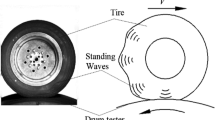Abstract
The sidewall is one of the regions where service failures occur in a pneumatic tire. Knowledge of the stresses or strains developed in the sidewall under varying service conditions is required if such pneumatic-tire failures are to be avoided. This paper describes an experimental investigation into the effect of inflation pressure, vehicle load and camber angle on the sidewall-surface strains in a radial tire. Photoelastic coating and a specially designed strain-gaging technique were used.
For pure-inflation pressure, the magnitude of the measured shear strains in the sidewall is directly related to the inflation pressure. The maximum sidewall shear strains in pure inflation are located in the lower sidewall (18 mm from bead), irrespective of the magnitude of the inflation pressure. The mendional sidewall strain is predominant in the inflated but otherwise unloaded tire. The meridional strain is proportional to the square root of the inflation pressure. The maximum mendional strain is located in the mid-sidewall region.
For a constant vehicle loading, there is a transition inflation pressure below or above which the circumterential shoulder strain increases sharply. This observation highlights the importance of maintaining satistactory inflation pressure in passenger-car tires as an under-inflated tire will induce severe strain development at the shoulder.
In addition to the vehicle load, the introduction of camber angle produces localized change in the meridional and circumterential strains within the contact zone. The increase of camber angle up to 10 deg causes continuous increase in the meridional strain in the lower sidewall but decrease in the upper sidewall. The mid-sidewall meridional strains remain practically unchanged. The circumferential strains along the load line are, in general, lower due to the increase in camber angle.
Similar content being viewed by others
References
Dobic, W.J., “Demographic Study of Tire Hazard Failures,”Rubber Chemistry and Technology,41 (4),1074–1079 (1969).
Janssen, M.I., andWalter, J.D., “Rubber Strain Measurements in Bias, Belted-Bias and Radial Ply Tires,”J. of Coated Fibrous Matls.,1,102–117 (Oct. 1971).
Davisson, J.A., Design and Application of Commercial Type Tires, Soc. of Auto. Engrs.,SP-344 (1969).
Walter, J.D., “Centrifugal Effects in Inflated, Rotating Bias-Ply Tires,”Textile Research J.,40 (1),1–7 (1970).
Purdy, J.F., Mathematics Underlying the Design of Pneumatic Tires, Edwards Brothers, Inc., Ann Arbor, MI (1963).
Dunn, S.E. andZorowski, C.F., A Study of Internal Stresses in Statically Deformed Pneumatic Tires, Office of Vehicle Systems Research Contract CST-376, U.S. National Bureau of Standards, Washington, DC (1970).
Brewer, H.K., Stresses and Deformations in Multi-ply Aircraft Tires Subject to Inflation Pressure Loading, U.S. Air Force Flight Dynamics, Laboratory AFFDL-TR-70-62, Wright Patterson Air Force Base, OH (1970).
Biderman, V.L., “Calculation of the Profile and Stresses in Elements of Pneumatic Tires under Inflation Pressure,”Trans. of the Tire Research Institute of Moscow (Nllsh P),3,16 (1973).
Brewer, H.K., “Tire Stress and Deformation from Composite Theory,”Tire Science and Tech.,1 (1),47–76 (1973).
Kaga, H., Okamoto, K. andTozawa, Y., “Stress Analysis of a Tire Under Vertical Load by a Finite Element Method,”Tire Science and Technology,5 (2),102–118 (1977).
Gough, V.E., “Stiffness of Cord and Rubber Construction,”Rubber Chemistry and Tech.,41,988–1021 (1968).
Clark, S.K., Measuring Tire Carcass Elastic Characteristics, SAE Paper 667C, Soc. of Auto. Engrs. (1963).
Robecchi, E., “Mechanics of the Pneumatic Tire, Part II, The Leminar Model under Inflation and in Rotation,”Tire Science and Tech.,1 (4),382–438 (1973).
Walter, J.D., “Cord-rubber Tire Composites: Theory and Applications,”Rubber Chemistry and Technology,51,524–576 (1978).
Lou, A.Y.C. andWalter, J.D., “Interlaminar-shear-strain Measurements an Cord-Rubber Composites,”Rubber Chemistry and Tech.,51 (4),793–804 (1979).
Szor, P. andPollak, T., “Study of Cord-Rubber Systems, with Special Reference to Modern Mathematical Methods,”Muanyag es Gumi,15 (5),T/10–14 (1978).
Biderman, V.L., Drozhzhin, P.K., Pugin, V.A. and Shchaveleva, V.F., “Experimental Investigation of Deformations in Elements of Pneumatic Tires,” Trans. Tire Research Institute (Nllsh P),5 (1957).
Pugin, V.A., “Effect of the Angle of the Cord on its Deformation in the Area of the Tire Wall,”Soviet Rubber Technology,22 (3),21 (1963).
Biderman, V.L. andPugin, V.A., “Wire Strain Gauge for Measurements of Large Deformation (Russian),”Zavodskaya Laboratoriya,24 (7),874 (1958).
Hurry, J.A. andWooley, R.P., “A New High Range Strain Gauge,”Rubber Age,73,799 (1959).
Kern, W.F., “Strain Measurements on Tires by Means of Strain Gauges,”R.G.C.,36 (10),1347–1365 (1959).
Biderman, V.L., Pugin, V.A. and Filks, G.S., “Deformations and Stresses in the Cover Rubber of the Sidewall of a Radial Tire,” Soviet Rubber Technology, 18–20 (July 1965).
Mezynoki, S.M. andUrbon, J.P., “Passenger Tire Sidewall Stress Analysis,”Presented at 99th Division Meeting of Rubber Chemistry, Paper No. 42, Amer. Chem. Soc., Miami, FL (April 1971).
Author information
Authors and Affiliations
Rights and permissions
About this article
Cite this article
Chow, C.L., Woo, C.W. The effect of inflation pressure and vehicle loading on the sidewall of a radial tire. Experimental Mechanics 21, 379–385 (1981). https://doi.org/10.1007/BF02324799
Received:
Accepted:
Issue Date:
DOI: https://doi.org/10.1007/BF02324799



